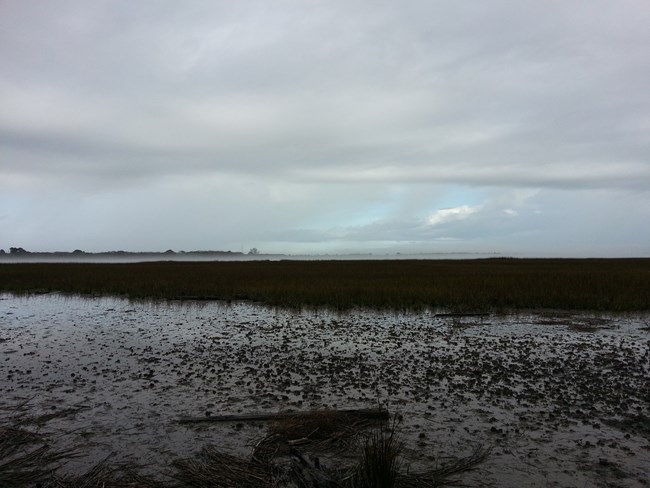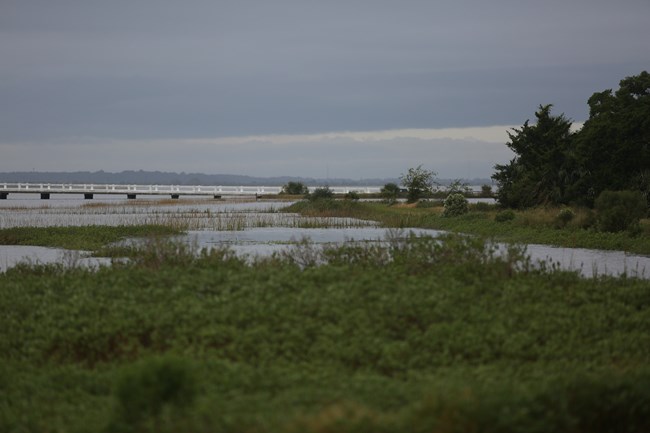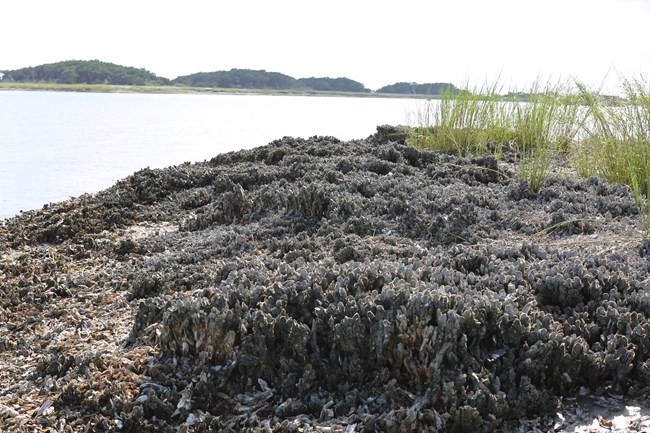
NPS Photo Accelerating ChangeEarth's temperature fluctuates naturally over tens of thousands to millions of years. However, we are currently experiencing unique conditions in Earth's history. Scientists have found that an increase in heat-trapping greenhouse gases like CO2 in the atmosphere from human activity, particularly the burning of fossil fuels, is the reason for the relatively recent rapidity of global warming. These rapid changes challenge the ability of living things to adapt and ultimately survive rapidly shifting environmental conditions, and amplify ongoing resource impacts such as habitat fragmentation, water scarcity, pollution, and invasive species. One society’s output of greenhouse gases affects the entire planet because wind currents and other atmospheric conditions ensure that the gases are not contained to one geographic area. This results in increasing global temperatures, increased frequency and intensity of weather events, shortages in food supply from drought, and even extinctions of plant and animal species. However, different regions experience different impacts as a results of climate change. One major impact of climate change on Fort Pulaski is sea level rise. See below for causes and impacts of sea level rise in coastal Georgia. 
NPS Photo/Joel Cadoff Rising Sea LevelsSea level rise is a global increase in ocean levels over an extended period of time. It has been apparent for over a century and will continue beyond the end of the 21st century, having substantial impact on the United States, particularly the roughly eight million people who live in coastal areas. Sea level rise is driven by global mechanisms such as warming seas and melting of ice on land as well as local mechanisms, which for the state of Georgia includes subsidence, ocean currents, water withdrawals from the Floridian aquifer, and tectonic displacement. Sea levels at Fort Pulaski have risen over nine inches since 1935, and scientists expect coastal Georgia to experience at least six inches of sea level rise within the next 50 years as a result of climate change, with nearly 420 square miles of the Georgia coast flooded due to sea level rise by 2110. With much of Georgia’s shoreline lying just a few feet above sea level, barrier islands and coastal communities are at risk for more frequent flooding, intensified storm surges, and saltwater intrusion in low-lying areas. 
NPS Photo - Davey Allen Losing History and TraditionsNational parks are repositories of human experience that chronicle the stories of our collective past. From the cliff dwellings of Mesa Verde to the steps of Ellis Island, each park reveals important chapters of our history. National parks support the lives of contemporary and indigenous people, and preserve valuable evidence about how earlier cultures responded to environmental change. These places provide important lessons for dealing with a warming world. Along the coast and in the interior, climate change threatens our cultural landscapes, historic structures, archeological sites, and traditional ecological knowledge. Rising sea levels inundate prehistoric shell mounds, coastal fortifications, and historic cemeteries. Persistent drought leads to falling lake levels, exposing archaeological sites to erosion from wave action and higher risks of looting and other disturbances. Increased flooding scours important landscapes and damages historic structures and museum collections. And delicate organic artifacts – tools of wood and bone, for example – are exposed to air as snow and ice fields melt, inducing rapid decay. The NPS actively works to inventory and monitor cultural resources, and uses modeling to help locate previously unknown archaeological sites. Vulnerability assessments are a valuable tool used to determine the relative risk climate change poses to cultural resources and prioritize management efforts. The NPS is working with local communities, traditional cultures, and historic preservation partners to identify appropriate actions and strategies to adapt cultural resources to a changing climate. 
NPS Photo Inspiration Through InnovationThe National Park Service has taken an agencywide interest in better understanding and preparing for the effects of climate change on park resources. Coastal parks such as Fort Pulaski National Monument are already seeing many of the effects predicted as a result of climate change: sea level rise, increases in temperature, and increases in frequency and intensity of weather events. Because of Cockspur Island’s physical location and historic drainage system, the monument and its resources are particularly vulnerable. Sea level rise has the potential to impair the use of gravity in these historic drainage systems that draw water away from the land on which the fort is constructed, and any increase in groundwater levels could also disrupt the island’s drainage. Any shift in water levels could contribute to flooding in the fort’s substructure as well as cause increases in mold, dampness, and standing water, all of which lead to rot and waterlogged vegetation. In the event of a hurricane or severe flooding, the historic 1830s fabric of the fort could be damaged or destroyed, and Highway 80, the only access point to the monument, could be submerged under water. An emergency response and recovery plan is needed that focuses on protecting monument resources during a natural disaster such as a major storm event or hurricane. A climate change adaptation plan would take a broader view and prescribe long term management activities to prepare for climate change and its effects. 
NPS Photo Share Your StoryToday, climate change is as much a part of the national park story as grasslands, glaciers, and grizzly bears. It is also a story we increasingly share in common with all our visitors. Climate change affects every person in some way. While some along the coast may see greater tidal flooding, others may experience stronger heat waves, persistent droughts, or an increased frequency in wildfires. Sharing your story is an important first step in bringing about the changes necessary to address climate change. Start a conversation in your community about how you are affected by climate change and what you can do to help.
References https://www.nps.gov/subjects/climatechange/index.htm https://www.nps.gov/articles/climatequestion01.htm https://www.nps.gov/articles/climatechangeisreal.htm https://www.nps.gov/articles/climatesciencefindings.htm https://gacoast.uga.edu/research/major-projects/sea-level-rise/ https://www.nps.gov/subjects/climatechange/upload/CCRP-Adaptation-Brief-2019Feb-508COMPLIANT.pdf https://www.nps.gov/subjects/climatechange/upload/CCRP-Coastal-Adaptation-Brief-2019May-508COMPLIANT.pdf https://www.nps.gov/subjects/climatechange/upload/CASH_FINAL_Document_111016.pdf http://slr.s3.amazonaws.com/factsheets/Georgia.pdf https://smartech.gatech.edu/handle/1853/48711 Climate Change in National Parks (NPS Pamphlet) Fort Pulaski National Monument Foundation Document |
Last updated: September 6, 2023
